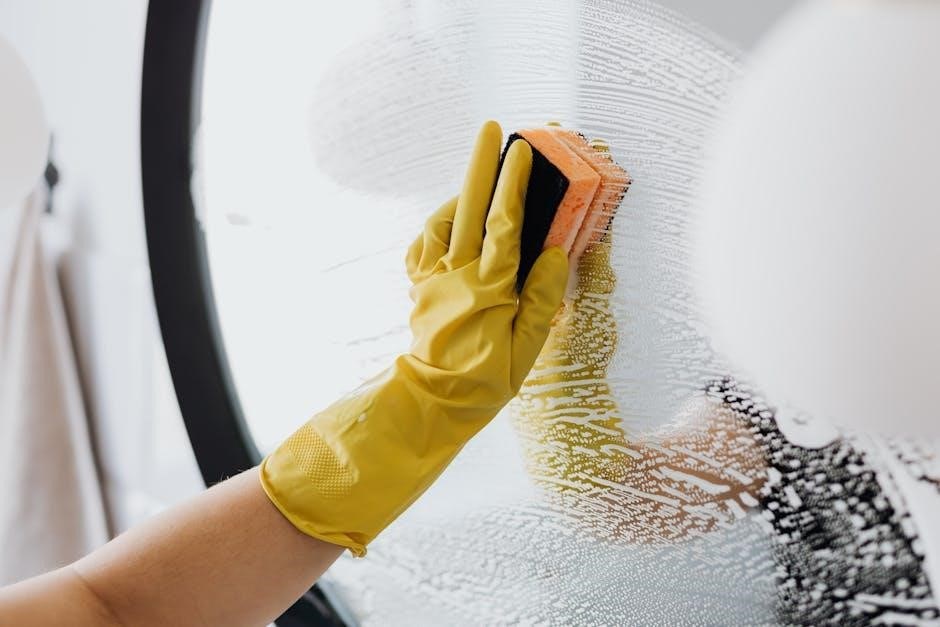Minky fabric is a soft‚ plush material known for its luxurious feel and vibrant colors․ It’s widely used in sewing projects‚ baby items‚ and home decor․
While durable‚ minky requires specific care to maintain its texture and appearance․ Proper washing and maintenance are essential to ensure its longevity and softness․
1․1 What is Minky Fabric?
Minky fabric is a soft‚ plush synthetic material often compared to velvet or fleece․ Known for its luxurious texture‚ it features a smooth‚ brushed surface and vibrant color retention․
Typically made from 100% polyester‚ minky is durable yet gentle‚ making it ideal for sewing projects like baby blankets‚ quilts‚ and apparel․ Its thick‚ velvety pile gives it a cozy feel․
The fabric is also lightweight and breathable‚ with a subtle sheen that enhances its visual appeal․ While it’s synthetic‚ minky mimics the softness of real fur‚ making it a popular choice for crafts․
1․2 Popular Uses of Minky Fabric
Minky fabric is widely used in sewing and crafting due to its soft‚ plush texture․ It’s a favorite for baby blankets‚ quilts‚ and stuffed animals․
Home decor projects like throw pillows‚ upholstery‚ and table runners also benefit from its vibrant colors and luxurious feel․
It’s popular in apparel for lining jackets‚ creating cozy scarves‚ and crafting baby clothing․ Minky is also ideal for DIY crafts‚ such as hair bows and accessories․
Its durability and softness make it perfect for items requiring comfort and style‚ ensuring it remains a versatile choice for crafters and sewists alike․
1․3 Why Proper Washing is Important
Proper washing is essential to maintain the softness and texture of minky fabric․ Improper washing can lead to pilling‚ fraying‚ or damage to the plush pile․
Color bleeding or fading can occur if minky is washed incorrectly‚ especially in hot water or with harsh detergents․ This can ruin the vibrant appearance of the fabric․
Regular washing keeps minky hygienic and fresh‚ preventing odors and bacteria buildup․ Using the right techniques ensures the fabric remains durable and retains its luxurious feel․
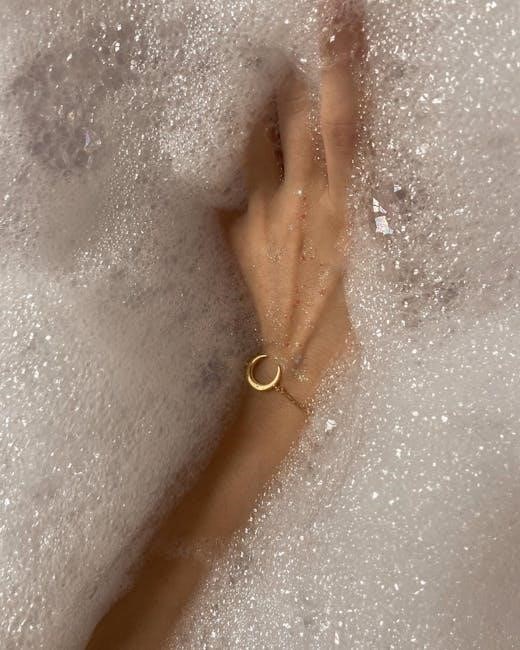
Following care guidelines helps extend the life of minky items‚ making them last longer and look their best․ Proper washing is key to enjoying minky fabric’s unique qualities․
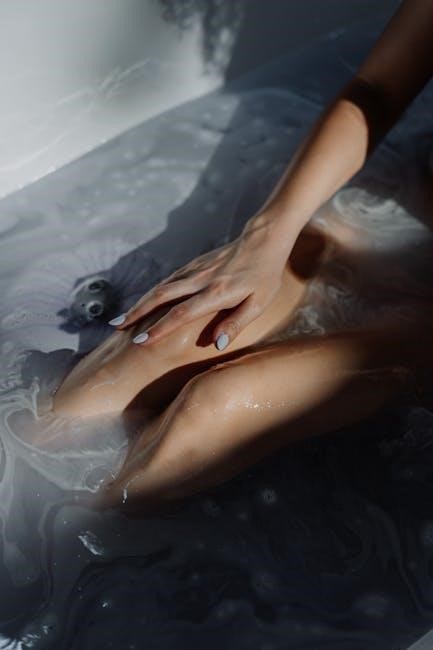
Understanding Minky Fabric Care
Minky fabric care requires attention to detail to preserve its softness and texture․ Unlike regular fabrics‚ minky needs gentle handling to avoid damage and maintain its plush appearance․
2․1 The Importance of Reading Labels
Reading the care label on minky fabric is crucial for maintaining its quality․ Each label provides specific instructions tailored to the fabric type and treatment required․ Ignoring these guidelines can lead to damage‚ such as shrinkage‚ pilling‚ or color bleeding․ The label will indicate whether the fabric can be machine washed‚ hand-washed‚ or requires dry cleaning․ It may also specify temperature settings‚ detergent types‚ and drying methods․ Following these instructions ensures the fabric retains its softness‚ texture‚ and vibrant colors․ Never assume all minky fabrics are treated the same‚ as variations in materials and finishes can affect care requirements․ Always prioritize label instructions for optimal results․
2․2 Common Misconceptions About Washing Minky
One common misconception is that minky fabric is too delicate to wash at home‚ but this is not true․ Many believe it requires dry cleaning‚ while most minky fabrics can be safely machine washed․ Another myth is that hot water is necessary to clean minky properly‚ but this can damage the fabric․ Some think fabric softeners are safe to use‚ but they can leave a residue that reduces softness․ Additionally‚ people often assume all minky fabrics can be treated the same‚ but variations in blends and finishes may require different care․ Understanding these myths helps ensure minky fabrics are washed correctly and maintain their quality․
2․3 Benefits of Proper Washing Techniques
Proper washing techniques preserve the softness‚ texture‚ and color of minky fabric․ Regular washing removes dirt and oils without damaging the plush pile․ It prevents pilling and fuzzing‚ maintaining the fabric’s luxurious feel․ Correct methods also ensure vibrant colors stay true and avoid fading․ Proper care extends the life of minky items‚ making them last longer․ It also prevents odors and keeps the fabric fresh․ By following the right techniques‚ you can enjoy the full benefits of minky fabric while maintaining its quality and appearance․ Proper washing is essential for keeping minky fabric in its best condition for years to come․

Materials Needed for Washing Minky
Essential supplies include a mild detergent‚ soft-bristle brush‚ and mesh laundry bags․ Optional items like vinegar and fabric refresher spray enhance care․
3․1 Essential Supplies
To wash minky fabric effectively‚ you’ll need a few key items․ A mild detergent designed for delicate or plush fabrics is crucial to prevent damage․ A soft-bristle brush can gently remove loose dirt or debris; Mesh laundry bags are recommended to protect the fabric during washing‚ especially for delicate or embellished items․ Cold water is essential to preserve the fabric’s color and softness․ Additionally‚ a gentle washing machine cycle or hand-washing basin is necessary․ These supplies ensure the fabric remains vibrant and plush while preventing pilling or fading․
Always avoid harsh chemicals or abrasive tools‚ as they can harm the fabric․ For hand washing‚ a clean‚ large basin and mild soap are sufficient․ Best practices include using a color-catching sheet if washing vibrant hues and avoiding fabric softeners to maintain texture․
3․2 Optional Supplies for Special Care
For extra care‚ consider using a fabric refresher spray to maintain minky’s softness and freshness between washes․ A static-reducing spray can help minimize cling‚ especially after drying․ If tackling stubborn stains‚ an enzyme-based stain remover can be effective without damaging the fabric․ A clean‚ white cloth for blotting stains is also handy․ For hand washing‚ a gentle agitator or soft sponge can help clean delicate areas․ While not necessary‚ these optional supplies enhance the washing process and help preserve the fabric’s quality․ They address specific needs like odor control‚ static reduction‚ and tough stains‚ ensuring your minky items remain vibrant and plush․
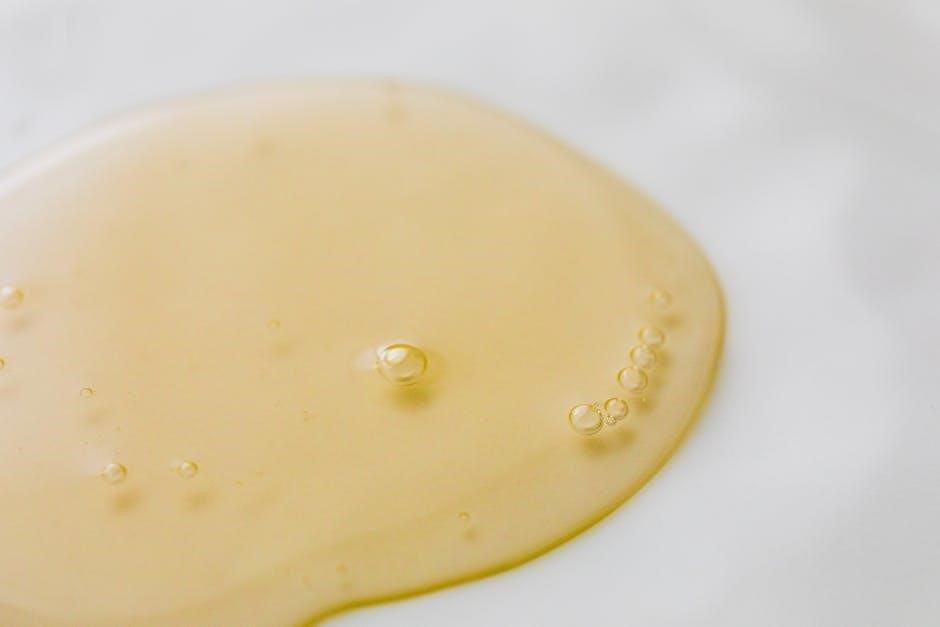
Step-by-Step Washing Guide
Start by checking labels‚ sorting items‚ and pre-treating stains․ Choose the right detergent‚ wash gently‚ and avoid fabric softeners․ Dry properly to maintain softness and texture․
4․1 Checking the Care Label
Always begin by examining the care label on your minky fabric․ It provides specific instructions tailored to the fabric type‚ ensuring optimal washing results․ The label may indicate whether the fabric can be machine washed‚ hand-washed‚ or requires dry cleaning․ It may also specify temperature settings‚ cycle recommendations‚ and any prohibited treatments․ Ignoring these guidelines can lead to damage‚ such as shrinking‚ fading‚ or loss of softness․ Some minky fabrics may require cold water‚ gentle cycles‚ or specialized detergents․ By following the care label‚ you can preserve the fabric’s texture‚ color‚ and durability․ This step is crucial for maintaining the quality of your minky items․
4․2 Sorting and Preparing Minky Items
Before washing‚ sort minky items separately from other fabrics to prevent snagging or damage․ Separate light and dark colors to avoid dye transfer․ Check for stains‚ zippers‚ or buttons that might cause friction or damage during washing․ Turn items inside out to protect the plush side and reduce pilling․ Remove loose threads or debris to prevent tangling․ Place delicate or heavily soiled items in mesh laundry bags for extra protection․ This step ensures that minky fabric remains soft and intact‚ while also preventing damage to other fabrics․ Proper preparation is key to a successful wash cycle and maintaining the fabric’s quality․
4․3 Pre-Treating Stains
Pre-treating stains on minky fabric is essential to ensure they don’t set in and damage the material․ Identify the type of stain‚ such as food‚ ink‚ or grease‚ and apply a gentle cleaning product or stain remover directly to the affected area․ For eco-friendly options‚ a mixture of equal parts water and white vinegar can be effective․ Gently rub the solution into the fabric using a soft cloth or your fingers‚ working from the outside of the stain inward․ Allow the treatment to sit for 10–15 minutes before rinsing with cold water․ Avoid harsh scrubbing‚ as it may damage the plush texture․ Always test a small‚ inconspicuous area first to ensure the cleaner doesn’t discolor the fabric․ This step ensures stains are removed effectively during the wash cycle․
4․4 Choosing the Right Detergent
Selecting the right detergent for washing minky fabric is crucial to maintain its softness and color vibrancy․ Opt for a mild‚ phosphate-free detergent specifically designed for delicate or synthetic fabrics․ Avoid harsh chemicals‚ bleach‚ or heavy-duty detergents‚ as they can damage the plush pile or cause fading․ For eco-conscious users‚ plant-based or eco-friendly detergents are excellent alternatives․ Fabric softeners should also be avoided‚ as they can leave a residue that dulls the fabric’s texture․ Always check the detergent’s label to ensure it’s suitable for the specific type of minky fabric you’re washing․ Using the right detergent helps preserve the fabric’s quality and prevents damage during the washing process․
4․5 Washing Minky in the Washing Machine
When washing minky fabric in a machine‚ use a gentle cycle with cold water to prevent damage․ Place the fabric in a mesh laundry bag for added protection․ Select a mild detergent and avoid fabric softeners or bleach‚ as they can harm the material․ Ensure the washing machine is not overloaded‚ allowing the fabric to move freely․ Check the care label for specific instructions‚ as some minky fabrics may require special settings․ Avoid using hot water‚ as it can cause the fibers to felt or the colors to bleed․ Gently remove excess water without wringing‚ and proceed to air dry or tumble dry on a low setting․ Proper machine washing helps maintain the fabric’s texture and prevents damage․
4․6 Hand Washing Minky Fabric
Hand washing minky fabric is a gentle and effective method for delicate or small items․ Fill a basin with cold water and add a small amount of mild detergent․ Gently submerge the minky fabric‚ working the soap into a lather with your hands․ Avoid agitating or rubbing the fabric vigorously‚ as this can cause pilling․ Let it soak for about 10 minutes‚ then rinse thoroughly under cold running water until all soap is removed․ Gently squeeze out excess water without wringing or twisting․ Lay the fabric flat on a clean towel to air dry․ Hand washing is ideal for maintaining the softness and texture of minky fabric‚ especially for items that require extra care․
4․7 Avoiding the Use of Fabric Softeners
Avoid using fabric softeners when washing minky fabric‚ as they can leave a residue on the fibers․ This residue can reduce the softness and breathability of the fabric over time․ Instead‚ opt for a gentle detergent specifically designed for delicate or plush fabrics․ Fabric softeners can also interfere with the fabric’s ability to absorb dye‚ potentially leading to fading or discoloration․ Additionally‚ residue from fabric softeners may affect the durability of minky fabric‚ causing it to pill or lose its texture more quickly․ Skipping fabric softeners helps preserve the natural texture and vibrant colors of minky fabric‚ ensuring it remains soft and luxurious for longer․
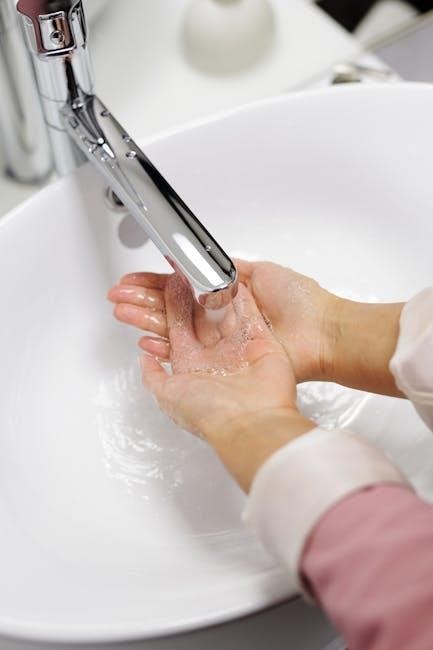
Drying Minky Fabric
Drying minky fabric requires careful attention to preserve its softness and texture․ Reshape items while damp‚ and avoid direct sunlight to prevent fading or shrinkage․
5․1 Air Drying Minky
Air drying is the recommended method for preserving the softness and texture of minky fabric․ Lay the fabric flat on a clean‚ dry surface or hang it gently to air dry․
Reshape the fabric while it is still damp to maintain its original dimensions․ Avoid exposing minky to direct sunlight‚ as this can cause fading or discoloration over time․
Choose a well-ventilated area indoors to prevent moisture buildup and ensure even drying․ Avoid using fabric dryers‚ as high heat can damage the fabric or cause pilling․
Air drying ensures the fabric remains plush and soft‚ maintaining its luxurious feel for longer․ This method is gentle and effective for preserving the quality of minky fabric․
5․2 Using a Tumble Dryer on Low Heat
When using a tumble dryer‚ always select a low heat setting to prevent damage to the minky fabric․ Place the fabric in a mesh laundry bag for added protection during the cycle․
Avoid using high heat‚ as it can cause pilling‚ shrinkage‚ or loss of softness․ Remove the fabric while it is still slightly damp to prevent overdrying․
Reshape the fabric gently while it is damp to maintain its original texture․ Do not leave minky in the dryer for an extended period‚ as this can lead to fuzzing or wear․
While tumble drying is more convenient than air drying‚ it is less gentle․ For best results‚ avoid using fabric softeners or dryer sheets‚ as they can leave a residue on the fabric․
5․3 Avoiding Direct Sunlight
Direct sunlight can cause minky fabric to fade and lose its vibrant colors․ Prolonged sun exposure may also weaken the fibers‚ leading to a less plush texture over time․
To preserve the quality‚ dry minky fabric in a shaded area or indoors․ If air drying‚ avoid placing it near windows or outside in direct sunlight․
For items that must be exposed to light‚ consider using a UV-blocking window covering or a breathable fabric shade․ This helps protect the fabric while allowing air circulation․
Remember‚ indirect light is safer for maintaining color and texture․ Always prioritize shaded drying to keep your minky fabric soft and vibrant for years to come․

Maintaining the Quality of Minky Fabric
Maintaining the quality of minky fabric requires gentle handling‚ proper storage‚ and timely washing to preserve its softness and vibrant appearance over time․
6․1 Storage Tips for Minky Items
To maintain the quality of minky fabric‚ store items in a cool‚ dry place away from direct sunlight․ Lay flat or hang to prevent stretching or creasing․
- Use a breathable storage bag or cloth to avoid moisture buildup․
- Avoid folding minky items excessively‚ as this can cause permanent creases․
- Keep minky fabric away from direct sunlight to prevent fading or discoloration․
- For long-term storage‚ consider using a fabric refresher to maintain a fresh scent․
- Do not stack minky items heavily‚ as this can damage the plush texture․
- Ensure items are clean before storing to prevent dirt or odors from setting in․
Proper storage helps preserve the softness‚ color‚ and texture of minky fabric for years to come․
6․2 Knowing When to Wash Minky Again
Determining when to wash minky items again depends on usage and condition․ If the fabric shows visible dirt‚ has a noticeable odor‚ or feels stiff‚ it’s time to wash․
- Wash minky items after heavy use or exposure to spills․
- Odors that linger even after airing out indicate the need for washing․
- If the fabric’s texture becomes rough or less plush‚ washing can restore softness․
- For items like blankets or clothing‚ wash every 3-6 months if used regularly․
- Always inspect for stains or discoloration before deciding to wash․
- Wash minky items before storing them long-term to prevent set-in odors or stains․
Regular washing helps maintain the fabric’s quality and ensures it remains soft and vibrant․
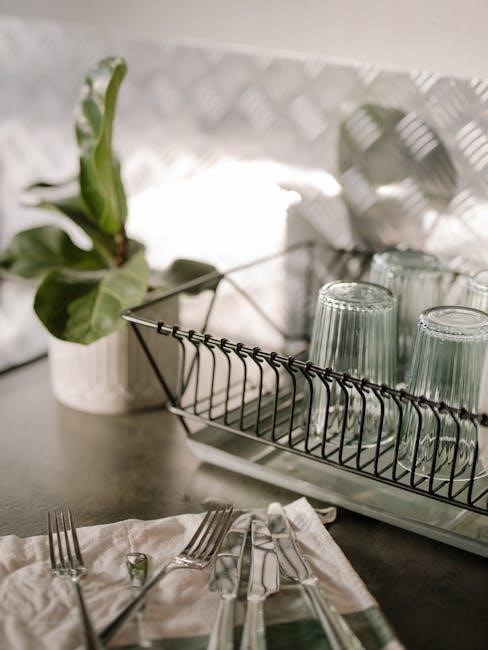
Troubleshooting Common Issues
Minky fabric can face issues like pilling‚ fading‚ or odors․ Addressing these problems early ensures the fabric remains soft and vibrant․ Proper washing techniques help prevent damage․
7․1 Dealing with Pilling or Fuzzing
Pilling or fuzzing on minky fabric occurs due to friction during washing or use․ To address this‚ gently remove pills with a fabric shaver or disposable razor․ Avoid using harsh brushes‚ as they may damage the fabric․ For prevention‚ wash minky items inside out and avoid rubbing them excessively․ Using a gentle detergent and a soft cycle can also help minimize pilling․ Regular maintenance ensures the fabric stays soft and plush․ If pilling is severe‚ consider professional cleaning or replacing the item․ Proper care extends the life of minky fabric‚ keeping it looking vibrant and smooth․
7․2 Fixing Fading or Color Bleeding
To address fading or color bleeding on minky fabric‚ start by washing the item in cold water with a mild detergent․ Avoid soaking‚ as this can exacerbate color loss․ For minor fading‚ adding a 1/2 cup of white vinegar to the rinse cycle can help restore vibrancy․ If colors have bled‚ rinse the fabric immediately and rewash it separately using a color-catching sheet to absorb excess dye․ Prevent future issues by washing minky items inside out and using a detergent designed for colorful or delicate fabrics․ Avoid direct sunlight‚ as it can cause fading․ Regular care ensures minky fabric retains its vibrant appearance and soft texture․
7․3 Removing Odors from Minky
To remove odors from minky fabric‚ start by washing it in cold water with a mild detergent specifically designed for delicate or colorful fabrics․ Add a 1/2 cup of white vinegar to the wash cycle to neutralize odors naturally․ For persistent smells‚ pre-treat the fabric by sprinkling baking soda directly on the affected area‚ let it sit for 15-30 minutes‚ then rinse thoroughly․ Avoid using fabric softeners or bleach‚ as they can damage the fabric or leave residues․ After washing‚ line dry the minky item to prevent musty smells from developing in a dryer․ Regular washing and proper drying will help keep minky fabric fresh and odor-free․
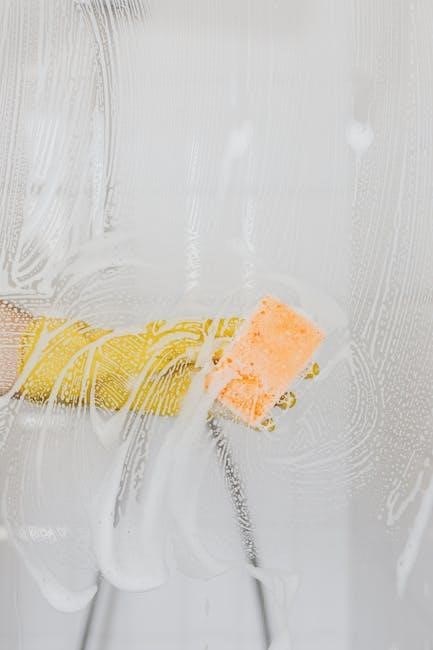
Eco-Friendly Washing Tips
Eco-friendly washing tips for minky fabric include using biodegradable detergents‚ washing in cold water‚ and line drying to conserve energy and protect the environment․
8․1 Using Eco-Friendly Detergents
Using eco-friendly detergents is a sustainable way to wash minky fabric․ Opt for biodegradable‚ phosphate-free detergents that are gentle on the fabric and the environment․ These detergents are free from harsh chemicals‚ preserving the softness and vibrancy of minky․ They are also less likely to cause irritation for sensitive skin‚ making them ideal for baby blankets or clothing․ Always choose detergents specifically designed for delicate or synthetic fabrics to ensure optimal care․ For an extra eco-conscious approach‚ consider using concentrated formulas or those packaged in recyclable materials․ This method not only protects your minky fabric but also supports a greener planet․
8․2 Washing in Cold Water
Washing minky fabric in cold water is essential to preserve its softness and vibrant colors․ Cold water prevents the fabric from shrinking‚ fading‚ or losing its plush texture․ It also helps maintain the integrity of the fibers‚ reducing the risk of pilling or fraying․ Hot water can damage minky by breaking down its synthetic fibers‚ leading to a rougher feel over time․ Additionally‚ cold water is eco-friendly as it consumes less energy․ For best results‚ use a gentle cycle with cold water and avoid agitation during the wash․ This method ensures your minky fabric remains soft‚ colorful‚ and durable for years to come․
8․3 Line Drying to Save Energy
Line drying minky fabric is an eco-friendly and energy-saving method that preserves its softness and texture․ Unlike machine drying‚ air drying prevents shrinkage and maintains vibrant colors․ Hang the fabric in a well-ventilated area‚ preferably in the shade‚ to avoid direct sunlight‚ which can cause fading․ Avoid folding or creasing the fabric while drying‚ as this can create permanent marks․ Line drying also reduces energy consumption‚ making it an environmentally responsible choice․ For best results‚ ensure the fabric is fully extended and allowed to air dry naturally․ This method not only saves energy but also helps maintain the plush feel of minky fabric for a longer period․
Properly washing and caring for minky fabric ensures its softness and longevity․ By following these guidelines‚ you can maintain its quality and enjoy its luxurious feel for years․
9․1 Summary of Key Points
Proper care for minky fabric involves gentle washing‚ avoiding harsh detergents‚ and minimizing heat․ Always check care labels‚ use cold water‚ and opt for air drying to preserve its softness and color․ Avoid fabric softeners and bleach‚ as they can damage the fabric․ For tough stains‚ pre-treat with mild solutions before washing․ Store minky items in a cool‚ dry place to prevent pilling or fading․ Regular maintenance ensures the fabric remains vibrant and plush over time․ By following these guidelines‚ you can enjoy your minky fabric for years while maintaining its luxurious quality and appearance․
9․2 Final Tips for Long-Lasting Minky Fabric
To ensure your minky fabric remains soft and vibrant‚ always prioritize gentle care․ Avoid direct sunlight‚ as it can cause fading‚ and store items in a cool‚ dry place․ Use eco-friendly detergents to minimize environmental impact while protecting the fabric․ For pilling or fuzzing‚ gently brush the fabric with a soft lint roller․ Avoid over-washing‚ as this can degrade the material․ When storing‚ fold items neatly rather than hanging them to prevent stretching․ By following these simple‚ consistent practices‚ you’ll enjoy your minky fabric’s luxurious feel and appearance for years to come․

Frequently Asked Questions (FAQs)
- Can minky fabric be ironed? Yes‚ but use low heat and avoid steam․
- Is minky fabric suitable for dry cleaning? No‚ hand or machine washing is recommended․
10․1 Can Minky Fabric Be Ironed?
Minky fabric can be ironed‚ but it requires careful handling to avoid damaging its soft‚ plush texture․ Use a low-heat setting and avoid steam‚ as excessive heat can harm the fabric․
Place the minky fabric on a flat surface‚ ensuring it is dry and free of wrinkles․ Use a pressing cloth or a piece of cotton fabric to protect it from direct heat․
Gently iron in the direction of the pile to maintain the fabric’s softness․ Never leave the iron stationary‚ as it can scorch or melt the synthetic fibers․
Ironing minky fabric is best done sparingly and only when necessary‚ as excessive heat can degrade its quality over time․
10․2 Is Minky Fabric Suitable for Dry Cleaning?
Minky fabric is generally not recommended for dry cleaning‚ as it is typically made from synthetic fibers like polyester‚ which do not require solvents for cleaning․
Dry cleaning can be harsh on minky fabric‚ potentially damaging its soft‚ plush texture or causing discoloration․ Most minky fabrics can be effectively cleaned with gentle machine or hand washing‚ making dry cleaning unnecessary․
If you must use professional cleaning‚ ensure the cleaner is experienced with synthetic fabrics․ However‚ for most cases‚ home washing with mild detergent is sufficient and safer for maintaining the fabric’s quality․
